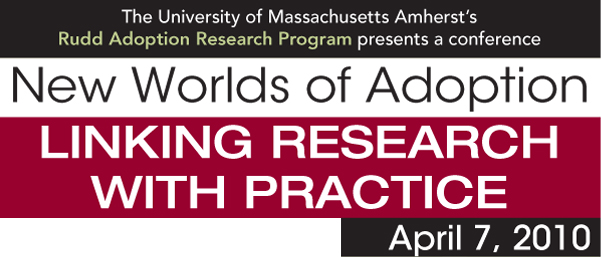Event Title
Patterns of Contact and Predictors of Openness in Adoptions: A Longitudinal Analysis
Location
University of Massachusetts at Amherst
Start Date
7-4-2010 4:00 PM
End Date
7-4-2010 5:30 PM
Description
Background: Open adoptions have not often been studied prospectively, especially since they have become more mainstream. One unexamined issue is how openness is regulated over time by adoptive families depending on the family's sense that contact with birth families is beneficial. Studying this question requires a longitudinal study that has multiple data points to allow analysis of how changes in adoption satisfaction are associated with changes in openness. This information can be used to inform adoptive parents about their options. This study examines patterns and predictors of openness among 378 adoptions from all four waves of the California Long-Range Adoption Study (CLAS).
Methods: Data were collected using four waves of mailed questionnaires (1991, 1993, 1997, 2003) completed by the adoptive parent. At Wave 4 (2003), adoptions were classified as being open (n=181) or closed (n=280), with openness defined as any contact between the adoptive child or family and the child’s birth parents or relatives. Patterns of contact across the four waves were tested using chi-square statistics and t-tests. A generalized linear mixed model (GLMM) was used to predict the binary outcome of open adoption (v. closed). This multilevel, longitudinal model accounts for nesting influences of multiple time points for each respondent. Multiple imputation methods were used to estimate values for missing data. Independent variables included years since Wave 1; child’s gender, ethnicity, and age at Wave 1; parent’s marital status at each wave; parent’s education; transracial adoption; parent’s perceptions at each wave of: control and comfort with contact; effect of contact on the adopted child and adoptive family; and parent’s level of satisfaction with the adoption at each wave.
Results: Contact with birth relatives declined from 1997 to 2003 (p
Implications: Adoptive families generally reported high levels of satisfaction with their adoptions, whether the adoption arrangements were open or closed. The finding that public agency adoptions are less likely to be associated with open arrangements points to the need for all adoptive arrangements to be assessed for the possibility of openness. Respondents’ perceptions of their children and families’ well-being over time had little to do with having an open adoption relationship, although greater family well-being predicted openness. These findings suggest that adoptive children and families are doing well as they continue to negotiate their relationships with birth families.
Patterns of Contact and Predictors of Openness in Adoptions: A Longitudinal Analysis
University of Massachusetts at Amherst
Background: Open adoptions have not often been studied prospectively, especially since they have become more mainstream. One unexamined issue is how openness is regulated over time by adoptive families depending on the family's sense that contact with birth families is beneficial. Studying this question requires a longitudinal study that has multiple data points to allow analysis of how changes in adoption satisfaction are associated with changes in openness. This information can be used to inform adoptive parents about their options. This study examines patterns and predictors of openness among 378 adoptions from all four waves of the California Long-Range Adoption Study (CLAS).
Methods: Data were collected using four waves of mailed questionnaires (1991, 1993, 1997, 2003) completed by the adoptive parent. At Wave 4 (2003), adoptions were classified as being open (n=181) or closed (n=280), with openness defined as any contact between the adoptive child or family and the child’s birth parents or relatives. Patterns of contact across the four waves were tested using chi-square statistics and t-tests. A generalized linear mixed model (GLMM) was used to predict the binary outcome of open adoption (v. closed). This multilevel, longitudinal model accounts for nesting influences of multiple time points for each respondent. Multiple imputation methods were used to estimate values for missing data. Independent variables included years since Wave 1; child’s gender, ethnicity, and age at Wave 1; parent’s marital status at each wave; parent’s education; transracial adoption; parent’s perceptions at each wave of: control and comfort with contact; effect of contact on the adopted child and adoptive family; and parent’s level of satisfaction with the adoption at each wave.
Results: Contact with birth relatives declined from 1997 to 2003 (p
Implications: Adoptive families generally reported high levels of satisfaction with their adoptions, whether the adoption arrangements were open or closed. The finding that public agency adoptions are less likely to be associated with open arrangements points to the need for all adoptive arrangements to be assessed for the possibility of openness. Respondents’ perceptions of their children and families’ well-being over time had little to do with having an open adoption relationship, although greater family well-being predicted openness. These findings suggest that adoptive children and families are doing well as they continue to negotiate their relationships with birth families.
